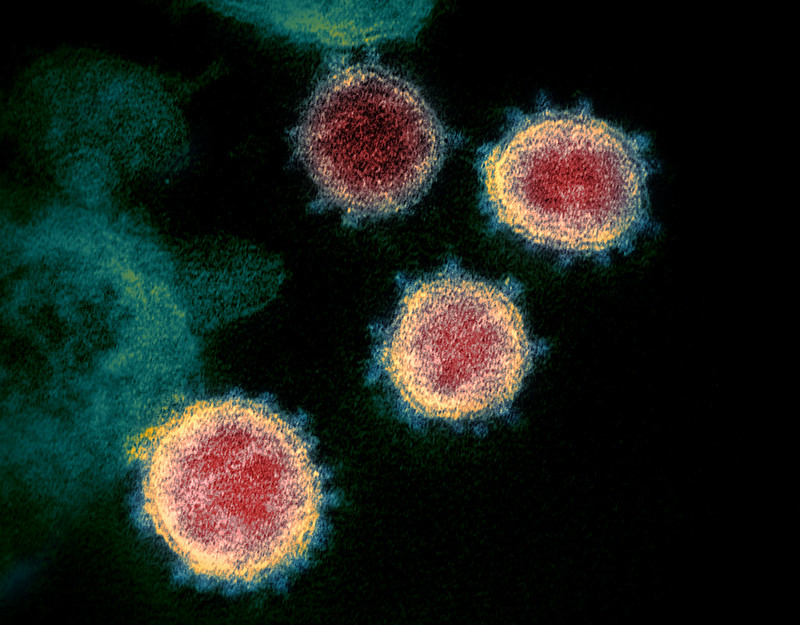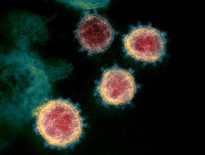
Credit: National Institutes of Healt / flickr
[Author’s note: This post was written on the afternoon of Wednesday, March 11, 2020. The subject matter is rapidly changing, and the recommendations below may be out of date in a few days. Find the latest recommendations from the LA County Dept of Public Health and the Centers for Disease Control through the links below.]
I wrote about the novel coronavirus outbreak ten days ago. The situation in LA County has changed since then.
In their daily press conference on Monday, the LA County Dept of Public Health announced the first documented case of community transmission of COVID-19. That’s the first person in LA County documented to have COVID-19 who didn’t have a travel history and wasn’t in close contact with someone with a travel history. Community transmission means just that – people in LA County are infecting people in LA County. That development on Monday led the Public Health Dept to recommend that people at high risk of having severe disease stay home as much as possible, avoid public gatherings, and practice social distancing. Groups thought to be at high risk are people 65 and older, people with chronic medical problems, and pregnant women. There is more detailed advice in today’s Department of Public Health News Release and at the CDC’s page for people at risk for serious illness, including the following list.
If you are at higher risk of getting very sick from COVID-19, you should:
- Stock up on supplies.
- Take everyday precautions to keep space between yourself and others.
- When you go out in public, keep away from others who are sick, limit close contact and wash your hands often.
- Avoid crowds as much as possible.
- Avoid cruise travel and non-essential travel.
- During a COVID-19 outbreak in your community, stay home as much as possible to further reduce your risk of being exposed.
Today’s press conference (which I recommend you watch) reported the second case of documented community transmitted infection. It also reported the first death in LA County from COVID-19. The number of documented cases is still quite low, 27, but this is certain to be an undercount. First, there are thought to be many cases of mild illness that have not come to medical attention. Second, some cases have not yet been counted because of insufficient tests and delays in testing. Of course, it’s impossible to know what the actual number of cases are. They are still likely to represent a tiny fraction of the 10 million residents of LA County, but the numbers may increase quickly, and our data will lag behind the actual situation.
Some college campuses have cancelled classes and are moving to online instruction. Many large events (including the American College of Physicians annual meeting, scheduled in Los Angeles for April) have been cancelled.
Meanwhile, the previous recommendations still apply.
- Stay home if you’re sick, even your symptoms are very mild.
- If you are mildly sick with a fever, stay home until you have been fever-free for 72 hours, except to get medical care.
- If you have a fever and cough or shortness of breath, call your doctor before arriving at your doctor’s office so that they can prepare to care for you while protecting themselves and their other patients.
- Don’t go to the emergency room with mild symptoms. Go to the emergency room only if you’re short of breath or can’t care for yourself at home.
- Wash your hands frequently.
- Cover your cough with a tissue.
- Don’t shake hands. (This recommendation is killing me, but I’m doing it. I’m the son of European immigrants. I was raised to always greet people with a handshake. I’ve been apologetically declining to do so since Monday, but it feels very impolite.)
For those not in the high-risk groups, some difficult decisions remain. Can we go to a movie theater? Should we? Should we all follow the guidelines for the high-risk groups? I have no evidence-based answers to these questions. I don’t even have guidance from health officials. But there are a few reasons that low-risk individuals might want to practice the precautions recommended for high-risk people. First, they might be the caregivers or household contacts of high-risk people. By protecting themselves, they protect their frailer loved ones. And second, even if they would get through the illness without complication, slowing the spread of the disease might make the difference between having plenty of ICU beds, ER beds, and test kits when the outbreak peaks and completely swamping our healthcare system. But obviously that has to be balanced with the fact that we don’t know how long this will last, staying inside for months might be miserable, and the risk (while unknown) might be low.
If you’re in a high-risk group, follow the recommendations. If you’re not, use your judgment. In either case, stay informed as this is likely to change over the next days and weeks.
Learn more:
People at Risk for Serious Illness from COVID-19 (Centers for Disease Control and Prevention)
Daily Novel Coronavirus Update with Public Health Officials 03-11-2020 (Los Angeles County Department of Public Health)
Los Angeles County Announces First Death Related to 2019 Novel Coronavirus (COVID-19)- Public Health Confirms First Death from COVID-19 and Six Additional Cases in Los Angeles County (Los Angeles County Department of Public Health)
